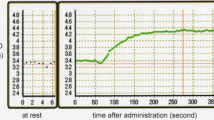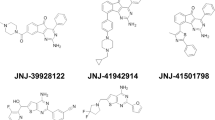Abstract
It has previously been shown that in migraine sufferers infusion of glyceryl trinitrate (GTN) and histamine causes an immediate headache during the infusion and a genuine migraine attack one to several hours after the infusion. This identical time profile indicates a common mechanism of action. To evaluate whether GTN causes headache via liberation of histamine, we studied the effect of GTN 0.5 ώg · kg−1·min−1 for 20 min in seven migraine sufferers, once after pretreatment with the histamine-1(H1)-receptor blocker mepyramine (0.5 mg · kg−1) and once without pretreatment. This mepyramine dose is known to completely abolish histamine-induced headache. After pretreatment with mepyramine five patients experienced migraine, and without pretreatment six patients did so. The median peak headache score was 7 on a 0–10 scale with and without mepyramine pretreatment. The arterial responses, evaluated with transcranial Doppler, were also unaffected by the mepyramine pretreatment. Our results demonstrate that neither headache nor arterial dilatation due to GTN infusion is caused by histamine release. In all likelihood the common mediator of migraine induction by GTN and histamine is nitric oxide.
Similar content being viewed by others
References
Thomsen LL, Kruuse C, Iversen HK, Olesen J (1994) A nitric oxide donor (nitroglycerin) triggers genuine migraine attacks. Eur J Neurol 1: 73–80
Lassen LH, Thomsen LL, Olesen J (1995) Histamine induces migraine via the H1 receptor. Support for the NO-hypothesis of migraine. Neuroreport 6: 1475–1479
Krabbe AÆ, Olesen J (1980) Headache provocation by continuous intravenous infusion of histamine. Clinical results and receptor mechanism. Pain 8: 253–259
Thomsen LL, Iversen HK, Brinck TA, Olesen J (1993) Arterial supersensivity to nitric oxide (nitroglycerin) in migraine sufferers. Cephalalgia 13: 395–399
Olesen J, Iversen HK, Thomsen LL (1993) Nitric oxide supersensitivity: a possible molecular mechanism of migraine pain. Neuroreport 4: 1027–1030
Olesen J, Thomsen LL, Iversen HK (1994) Nitric oxide is a key molecule in migraine and other vascular headaches. TIPS 15: 149–153
Roznieck JJ, Kuzminska B, Prusinski A (1989) Possible mechanism of nitroglycerin induced cluster headsche attack—a proposal explanation. Cephalalgia 9 (Suppl 10): 80–81
Headache Classification, Committee of the International Headache Society (1988). Classification and diagnostic criteria for headache disorders, cranial neuralgias and facial pain Cephalagia 8 (Suppl 7): 19–28
Iversen HK, Olesen J, Tfelt-Hansen P (1989) Intravenous nitroglycerin as an experimental model of vascular headache. Basic characteristics. Pain 38: 17–24
Aaslid R (ed) (1986) Transcranial Doppler sonography. Springer, Berlin Heidelberg New York
Thomsen LL, Iversen HK (1993) Experimental and biological variation of three dimensional transcranial Doppler measurement. J Appl Physiol 75: 2805–2810
Thomsen LL, Iversen HK (1994) CO2 measurements during transcranial Doppler examinations in headache patients: methodological considerations. Cephalalgia 14: 245–247
Baaske DM, Amann AH, Karnatz NN, Wong J, Wagenknecht DM, Carter JE, Stoll RG (1982) Administration set suitable for use with intravenous nitroglycerine. Am J Hosp Pharm 39: 121–122
Altman DG (1991) Comparing groups—categorical data. In: Altman DG (ed) Practical statistics for medical research. 1st edn. Chapman and Hall, London, pp 235–239
Matthews JNS, Altman DG, Cambell MJ, Royston P (1990) Analysis of serial measurements in medical research. BMJ 300: 230–235
Masini E, Di Bello MG, Pistelli A, Raspanti S, Gambassi F, Mugnai L, Lupini M, Mannaioni PF (1994) Generation of nitric oxide from nitrovasodilators modulates the release of histamine from mast cells. J Phys Pharmacol 45 (1): 41–53
Ter Laak AM, Tsai RS, Donne-op den Kelder GM, Carrupt PA, Testa B, Timmerman H (1994) Lipophilicity and hydrogenbonding capacity of H1 antihistaminic agents in relation to their central sedative side-effects. Eur J Pharm Sci 2: 373–384
Iversen HK, Olesen J (1994) Nitroglycerin-induced headache is not dependent on histamine release. Support for a direct nociceptive action of nitric oxide. Cephalalgia 6: 437–443
Iversen HK, Nielsen TH, Garre K, Tfelt-Hansen, Olesen J (1992) Dose dependent headache response and dilatation of limb and extracranial arteries after three doses of 5-isosorbide-mononitrate. Eur J Clin Pharmacol 42: 31–35
Iversen HK (1992) N-Acetylcysteine potentiates nitroglycerin induced headache and dilatation of cranial but not extremity arteries. Clin Pharmacol Ther 52: 125–133
Ignarro LJ, Lippton H, Edwards JC, Baricos WH, Hyman AL, Kadowitz PL, Gruetter CA (1981) Mechanisms of vascular smooth muscle relaxation by organic nitrates, nitrites, nitroprusside and nitric oxide: evidence for the involvement of S-nitrosothiols as active intermediates. J Pharmacol Exp Ther 218: 739–749
Axelsson KL, Wikberg JE, Anderson RG (1979) Relationship between nitroglycerin, cyclic GMP and relaxation of vascular smooth muscle. Life Sci 24: 1779–1789
Toda N (1990) Mechanism underlying responses to histamine of isolated monkey and human cerebral arteries. Am J Physiol 258: H311-H317
Fujiwara M, Usui H, Kurahashi K, Jino H, Shirahase H, Mekata F (1992) Endothelium dependent contraction produced by acetylcholine and relaxation produced by histamine in monkey basilar arteries. J Cardiovasc Pharmacol 20: 114–116
Dahl A, Russell D, Nyberg-Hansen R, Rootwell K (1989) Effect of nitroglycerin on cerebral circulation measured by transcranial Doppler and Spect. Stroke 20: 1733–1736
Krabbe AÆ, Olesen J (1982) Effects of histamine on cerebral blood flow in man. Cephalalgia 20: 15–18
Author information
Authors and Affiliations
Rights and permissions
About this article
Cite this article
Lassen, L.H., Thomsen, L.L., Kruuse, C. et al. Histamine-1 receptor blockade does not prevent nitroglycerin induced migraine. Eur J Clin Pharmacol 49, 335–339 (1996). https://doi.org/10.1007/BF00203773
Received:
Accepted:
Issue Date:
DOI: https://doi.org/10.1007/BF00203773




